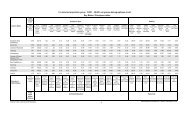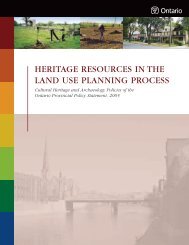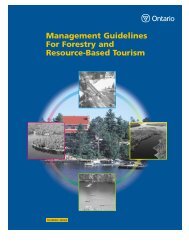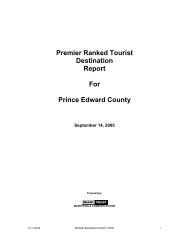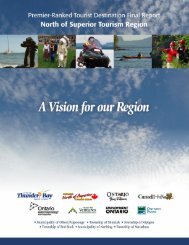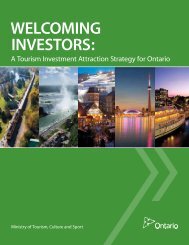Factors Influencing Visitor's Choices of Urban Destinations in North ...
Factors Influencing Visitor's Choices of Urban Destinations in North ...
Factors Influencing Visitor's Choices of Urban Destinations in North ...
You also want an ePaper? Increase the reach of your titles
YUMPU automatically turns print PDFs into web optimized ePapers that Google loves.
also found that almost half <strong>of</strong> the visitors to a cultural sight expected to be enterta<strong>in</strong>ed.Other motivations <strong>in</strong>cluded a visit <strong>in</strong> order to learn new th<strong>in</strong>gs and experience “theatmosphere” <strong>of</strong> the place.Lew’s work (1987) focused on the attractors <strong>of</strong> a rural dest<strong>in</strong>ation and ranked a range <strong>of</strong>general factors that <strong>in</strong>fluence the attractiveness <strong>of</strong> a dest<strong>in</strong>ation. The most importantfactors were the natural beauty and climate followed <strong>in</strong> order by cultural and socialcharacteristics, attitudes towards tourists, accessibility <strong>of</strong> the region, <strong>in</strong>frastructure <strong>of</strong> theregion, price levels, sport/recreational facilities and shopp<strong>in</strong>g/commercial facilities. All <strong>of</strong>these results relate to the quality <strong>of</strong> the tourist’s experience at the attraction itself, andsuggest the importance <strong>of</strong> measur<strong>in</strong>g this quality <strong>in</strong> classify<strong>in</strong>g an attraction.Dest<strong>in</strong>ation Competitiveness LiteratureDest<strong>in</strong>ation Competitiveness Literature describes key foundations for develop<strong>in</strong>g acomprehensive tourism model. Not only the core resources and attractors <strong>of</strong> thedest<strong>in</strong>ation are important, but also the dest<strong>in</strong>ation management, dest<strong>in</strong>ation policy andmacro and microenvironment help to def<strong>in</strong>e a successful tourism sector.“Competitiveness <strong>in</strong> the tourism sector is def<strong>in</strong>ed as the ability <strong>of</strong> the tourism marketenvironment and conditions, tourism resources, tourism human resources, and tourism<strong>in</strong>frastructure <strong>in</strong> a country to create an added value and <strong>in</strong>crease national wealth. That isto say, ‘the competitiveness <strong>in</strong> the tourism sector’ is not only a measure <strong>of</strong> potentialability, but also an evaluation <strong>of</strong> present ability and tourism performance 21 ”. Articles byKim (2000), Crouch and Ritchie (1999 and 2000) and Dwyer and Kim (2001) provide avaluable discussion on this topic.“A Study on an Evaluation Model for Competitiveness <strong>of</strong> the Tourism Industry”Kim (2000) developed a competitiveness model for the tourism <strong>in</strong>dustry and its<strong>in</strong>dicators. The model has four dimensions <strong>of</strong> competitiveness <strong>in</strong>clud<strong>in</strong>g primaryresources <strong>of</strong> competitiveness (i.e. environment and resources); secondary sources (i.e.tourism plann<strong>in</strong>g, tourism management, and tourism <strong>in</strong>vestment, etc.); tertiary sources(i.e. tourism <strong>in</strong>frastructure, attractiveness <strong>of</strong> resources, reception system, etc.); and afourth level <strong>of</strong> sources related to tourism demand, tourism employment and tourismexport. These four categories determ<strong>in</strong>e the competitiveness <strong>of</strong> a tourism <strong>in</strong>dustry.Criticism: One <strong>of</strong> the ma<strong>in</strong> criticisms 22 <strong>of</strong> this model is that the categories used to def<strong>in</strong>ethe components <strong>of</strong> this model are somewhat arbitrary. There is no justification to theassignment <strong>of</strong> resources to each level (primary, secondary, tertiary, and level four). Inparticular, there is some <strong>in</strong>consistency as to how the “resources” are def<strong>in</strong>ed among thefour categories. Some overlap appears to occur.Similar to the Crouch-Ritchie model, Kim’s model is l<strong>in</strong>ear and thus it fails toacknowledge potential <strong>in</strong>teractive effects between different sources <strong>of</strong> dest<strong>in</strong>ationcompetitiveness 23 .21 Kim (2000).22 Ibbd.23 Ibbd.45


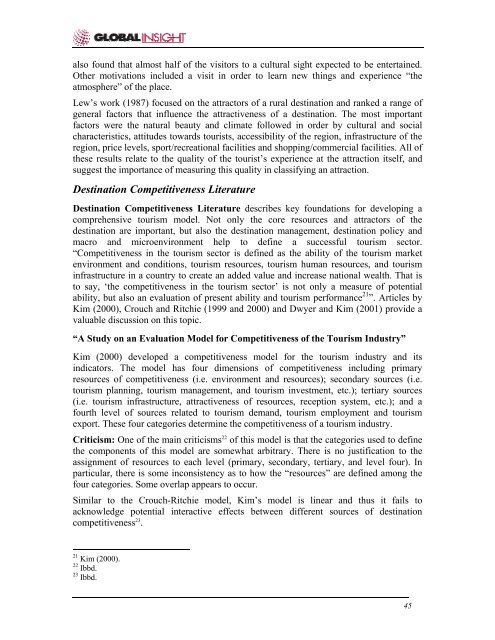
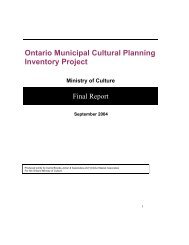
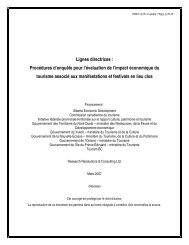
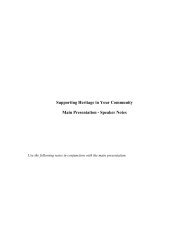
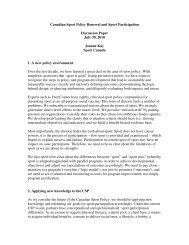
![THIS AGREEMENT made this [date], between [name of owner] (the ...](https://img.yumpu.com/49827605/1/158x260/this-agreement-made-this-date-between-name-of-owner-the-.jpg?quality=85)

